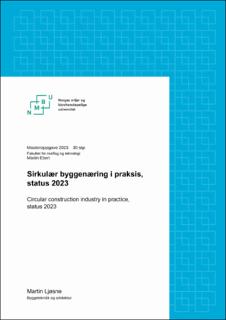| dc.contributor.advisor | Martin Ebert | |
| dc.contributor.author | Ljøsne, Martin Budin | |
| dc.date.accessioned | 2023-08-19T16:27:14Z | |
| dc.date.available | 2023-08-19T16:27:14Z | |
| dc.date.issued | 2023 | |
| dc.identifier | no.nmbu:wiseflow:6780174:53392133 | |
| dc.identifier.uri | https://hdl.handle.net/11250/3084913 | |
| dc.description.abstract | Byggenæringen bidrar stort til det totale miljøfotavtrykket i Norge, og er fastlandets største næring i omsetning og antall arbeidsplasser. Næringen anses for å stå for 40% av alt CO2-utslipp, avfall og energiforbruk i landet (Tekna, 2022). Dette grunnes hovedsakelig at bransjen følger en lineær forretningsmodell som baserer seg på en produksjonsmodell hvor naturens ressurser brukes og kastes etter bruk uten å utnyttes til sitt fulle potensial.
Innføringen av sirkulær økonomi i byggenæringen utfordrer nåtidens lineære forretningsmodeller, og har som mål å øke ressursutnyttelsen, danne sirkulære verdikjeder og fremme grønn økonomisk vekst. Den sirkulære økonomien har som mål å redusere de miljømessige fotavtrykkene bransjen står for i dag. Som bidrag til omstillingen mot en sirkulær fremtid er det utarbeidet innovasjonsprogrammer og sertifiseringsmetoder som skal fungere som rettesnorer og veiledere for aktørene i byggeprosjekter. Disse stiller krav til prosessene i prosjekter slik at aktørene tenker mer fremtidsrettet når de bygger nybygg eller rehabiliterer eksisterende bygg.
Denne studien har som mål å kartlegge status på innføringen av FutureBuilts kriteriesett for sirkulære bygg i Norge samt utforske fremtidens gjøremål for overgangen til en sirkulær byggenæring. Informasjon er innhentet ved hjelp av intervjuer med representanter fra byggenæringen og en digital spørreskjemaundersøkelse utsendt til bygningsentreprenører i Oslo og omegn. Intervjudataene er analysert ved å bruke en innholdsanalyse og resultatene fra spørreskjemaundersøkelsen er presentert.
Overordnet konkluderes det i denne oppgaven med at innføringen av FutureBuilt kriteriene krever mye tid og ressurser og at det er stort behov for nye innovasjoner og metoder for å akselerere omstillingen. FutureBuilts kriterier bringer nye utfordringer og muligheter som må tas hensyn til ved å samarbeide med andre aktører. For å akselerere overgangen må store endringer tre i kraft, og det er behov for nye insentiver som motiverer bransjen ytterligere. | |
| dc.description.abstract | The construction industry largely contributes to the total environmental footprint in Norway, and is the mainland's largest industry in terms of revenue and number of jobs. The industry is estimated to account for 40% of all CO2 emissions, waste and energy consumption in the country (Tekna, 2022). This is because the industry follows a linear business model, which is based on a production model where nature's resources are used and discarded without being exploited to their full potential.
The introduction of a circular economy in the construction industry challenges today's linear business models and aims to increase resource utilization, establish circular value chains and promote green economic growth. The circular economy aims to reduce the environmental footprints the industry is responsible for today.
As a contribution to the transition towards a circular future, innovation programs and certification methods have been developed to function as guidelines for companies in construction projects. These make various demands on processes in projects to ensure that companies work in a more forward-looking manner when they build new buildings or rehabilitate existing ones.
The aim of this study is to map the status of the introduction of the FutureBuilt set of criteria for circular buildings in Norway as well as to explore future tasks for the transition to a circular construction industry. Information has been obtained using interviews with representatives from the construction industry and a digital questionnaire survey sent to building contractors in Oslo and the surrounding area. The interview data has been analyzed using a content analysis and the results from the questionnaire survey are presented.
Overall, this thesis concludes that the introduction of the FutureBuilt criterias require a lot of time and resources and that there is a great need for new innovations and methods to accelerate such transition. The FutureBuilt criterias bring new challenges and opportunities that must be considered by collaborating with other companies. To accelerate the transition, major changes must come into effect, and new incentives are needed to further motivate the industry. | |
| dc.language | nob | |
| dc.publisher | Norwegian University of Life Sciences | |
| dc.title | Sirkulær byggenæring i praksis, status 2023 | |
| dc.type | Master thesis | |
